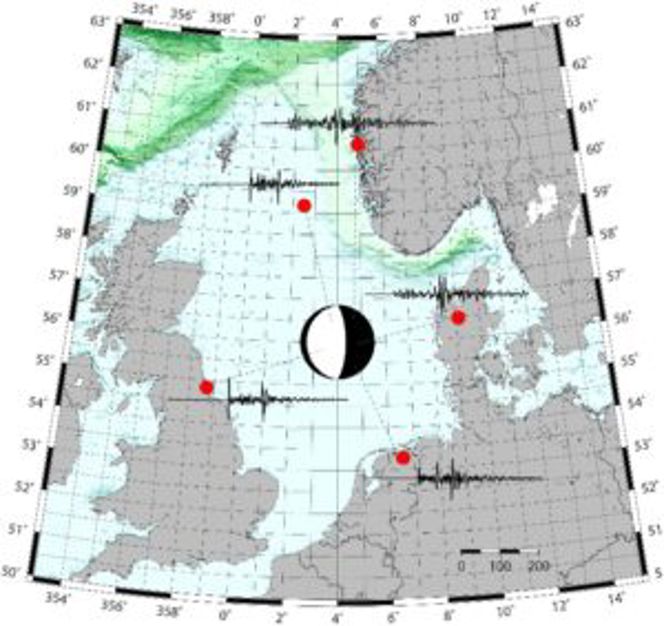Work Package 2: Seismicity
WP lead: Daniela Kuehn, NORSAR. E-mail: daniela@norsar.no
The main objective of WP2 is to significantly improve knowledge of the present-day stress field in the North Sea from a new extensive database of earthquake focal mechanisms. In combination with observations of stress drop, seismic anisotropy, and borehole data, this will ultimately provide missioncritical insights on caprock integrity around the case study sites and provide valuable insights on actively slipping faults.
Task 2.1 – Integration of seismicity data and focal mechanism database
By combining seismicity data from various onshore and offshore arrays, we will be able to not only improve the detection threshold of local and regional seismicity in the vicinity of the planned CCS sites, but also significantly improve location and focal mechanism uncertainty.
Existing seismicity catalogs for the North Sea are far from complete and are in general only including larger magnitude events (>M3). Small earthquakes are typically recorded on fewer seismographs than larger ones, and it is therefore crucial to include all available data. As earthquakes smaller than ML 3.0 are underreported to international agencies, data integration among neighboring countries is an important part of the process.
We will work on an updated and expanded catalog towards lower magnitude events. By applying advanced event location methodologies and a probabilistic approach for focal mechanism analysis we expect to significantly improve the initial catalog and include smaller events with lower signal-to-noise ratios. As part of updating the catalog, different magnitude scales will be compared, and scaling relations may be estimated.

Task 2.2 – Borehole stress observations
A comprehensive catalogue of borehole stress orientations will be compiled from available borehole breakouts and in situ stress data. The work will take advantage of stress data shared by storage operators including data utilized for the stress model and access well stress databases for the North Sea. The well stress data will be combined with stress observations from earthquake focal mechanisms, data in the World Stress Map and other published data to estimate the regional stress field.
Task 2.3 Crustal strength evaluation based on stress drop analysis
Measurement of earthquake stress drop helps to further characterize the geodynamic behavior of the storage sites. Stress drop, i.e., the difference of the stress magnitude before and after an earthquake can be measured from the spectrum of the earthquake source signature. We will estimate relative stress drops of the event catalog developed in task 2.1.
Spatial variations of stress drop are indicative of crustal strength and hence can provide another proxy for caprock integrity, in combination with Mohr-Coulomb stress modeling and other observations. This analysis will focus on sites where more detailed stress parameters will be available such as the Horda Platform area.
Task 2.4: Measurements of seismic anisotropy
Measurements of seismic anisotropy, either from shear-wave splitting in earthquake data, or from 3D seismic data, can further corroborate the stress directions inferred from the focal mechanism inversion. Anisotropy measurements combined with stress observations will also contribute to caprock integrity assessment, as shales constitute the caprock at most of the considered sites.